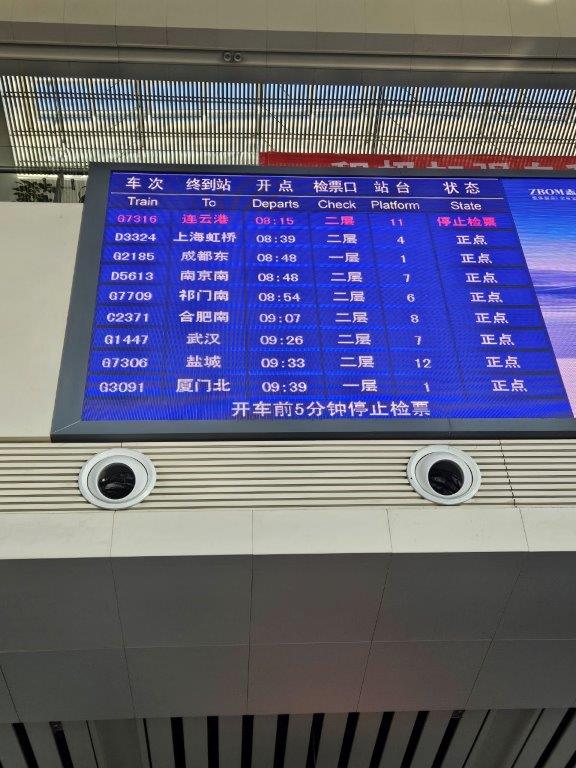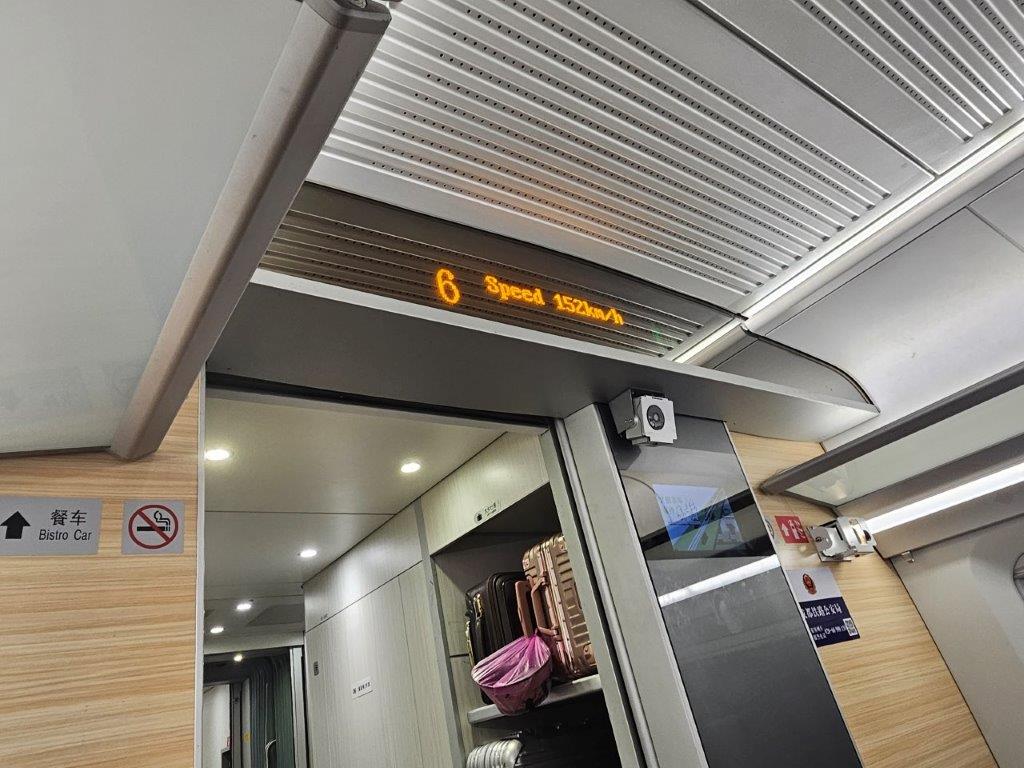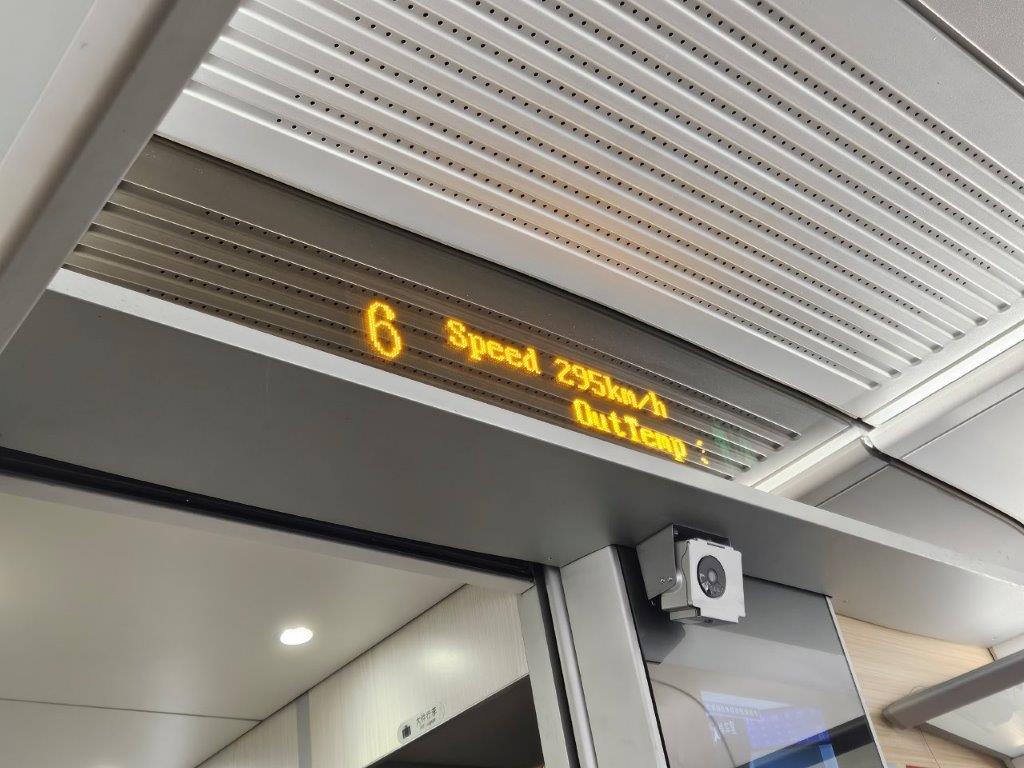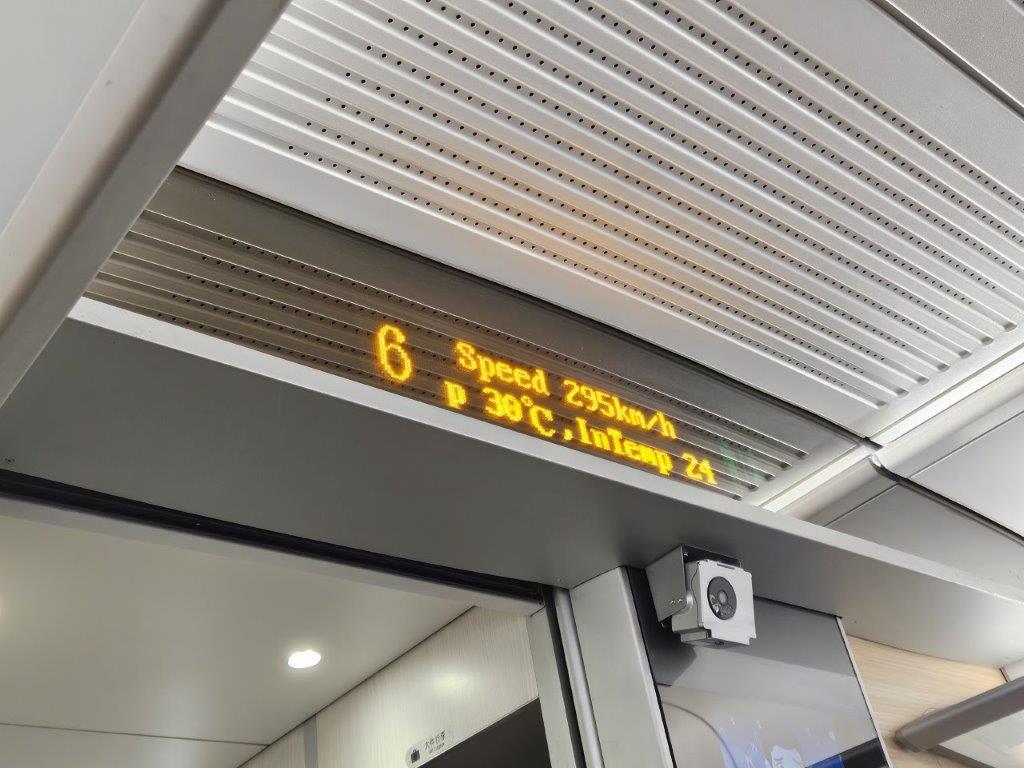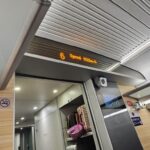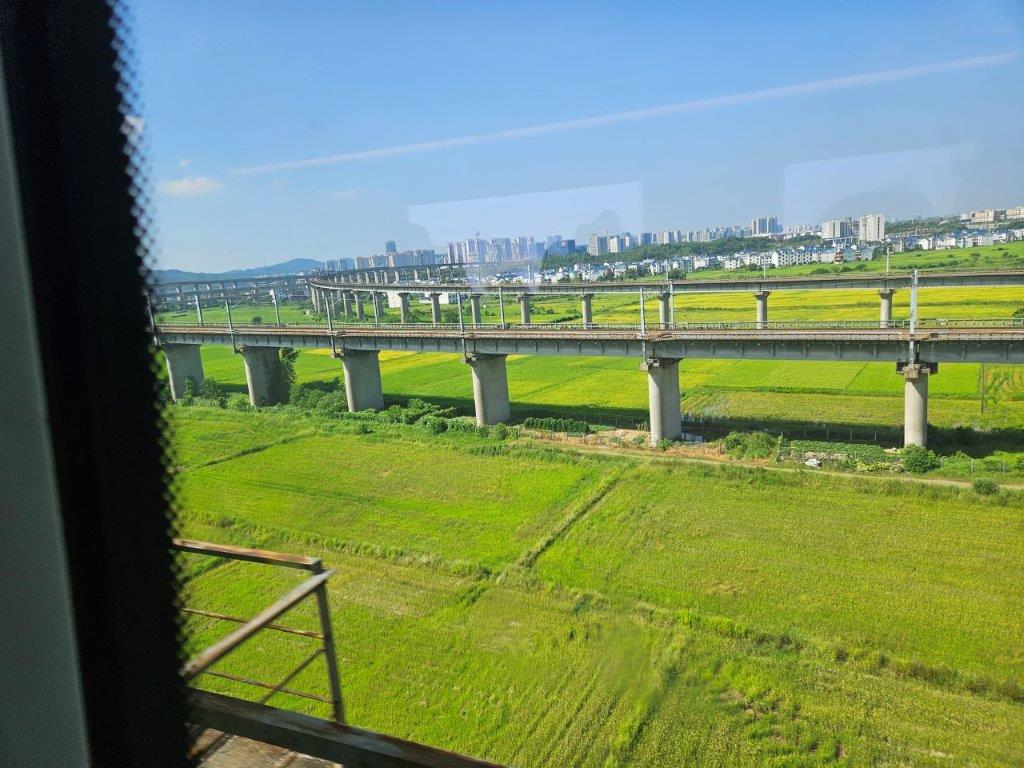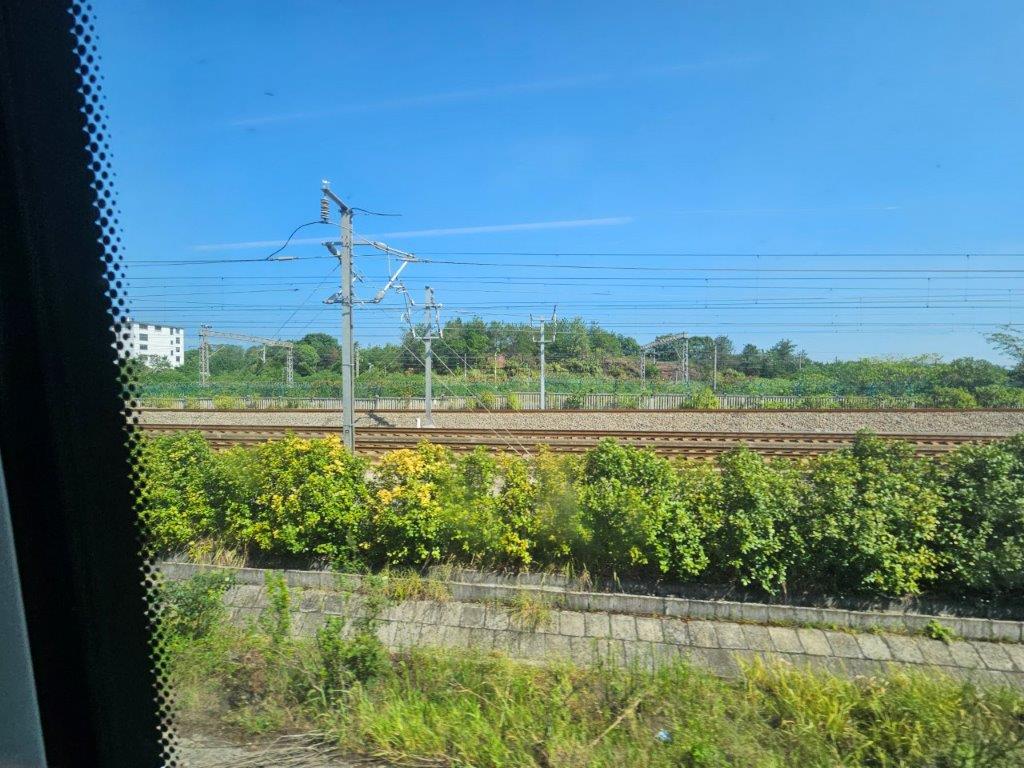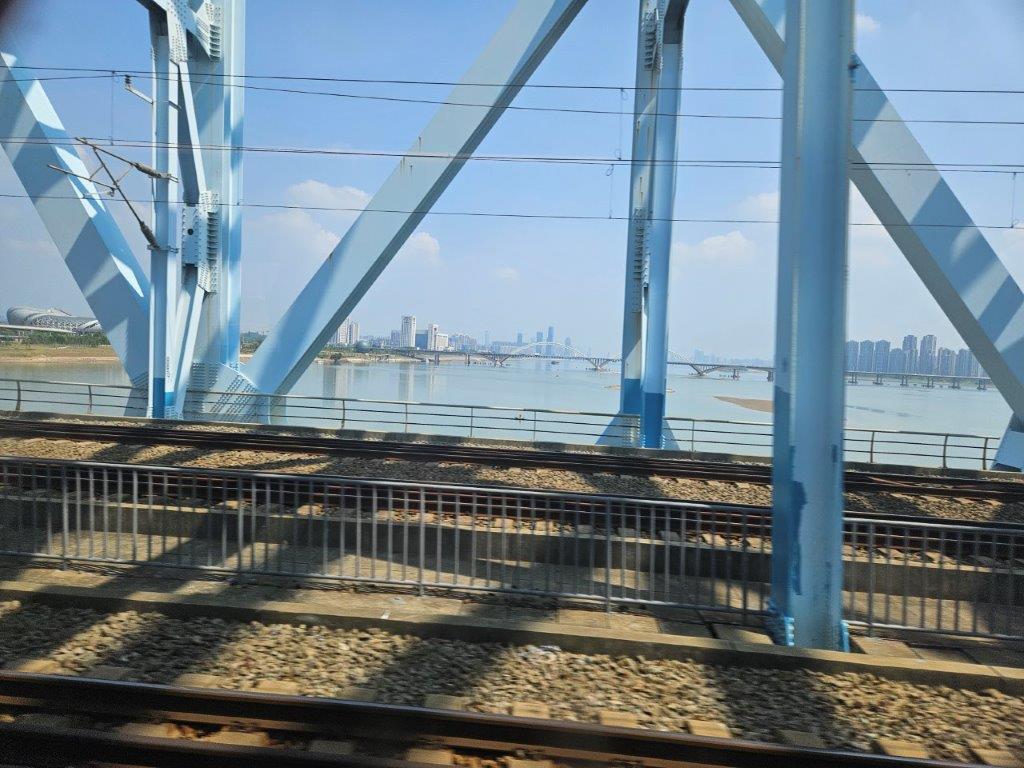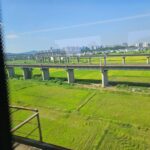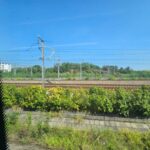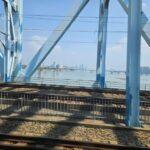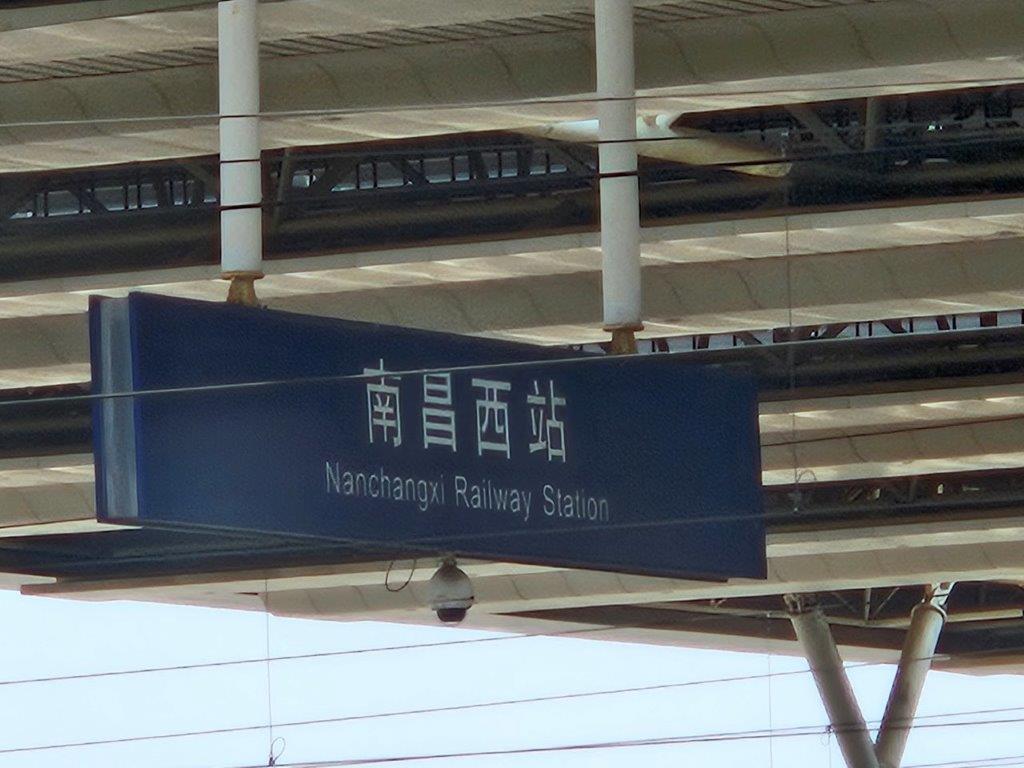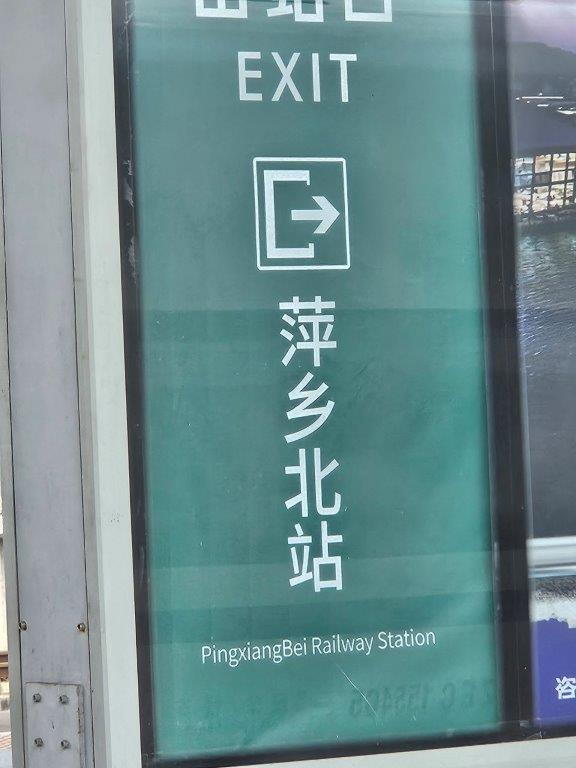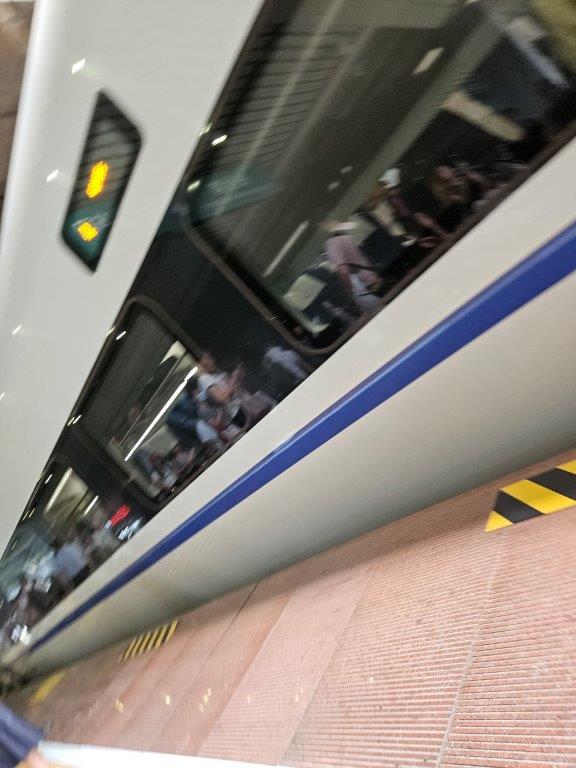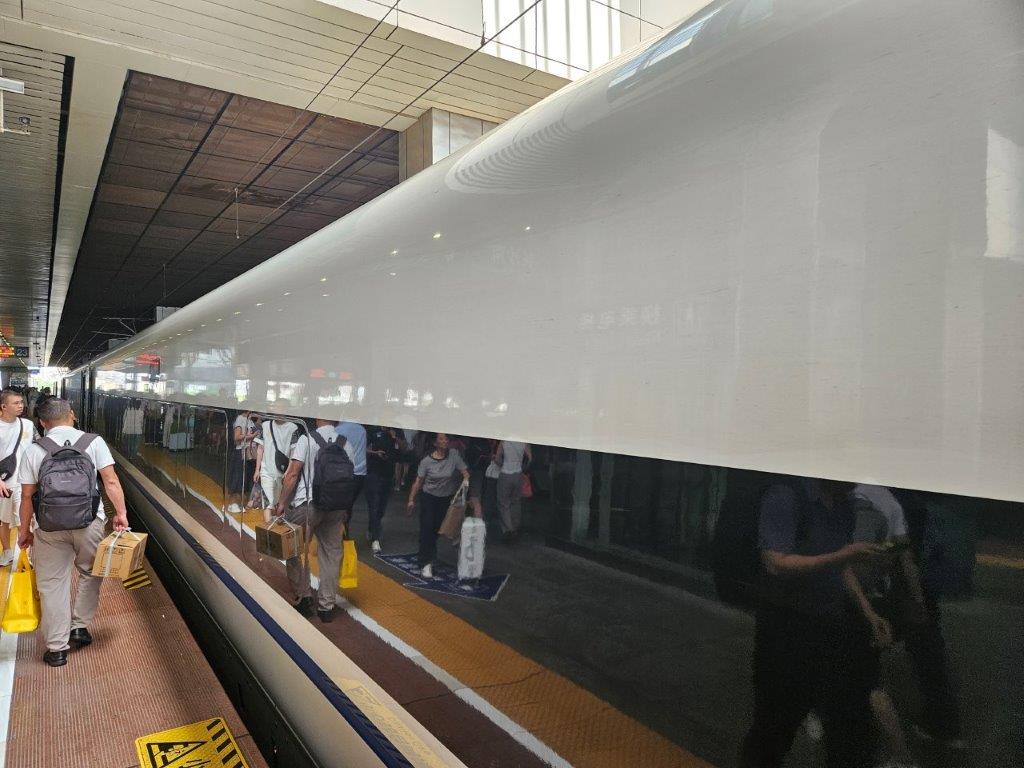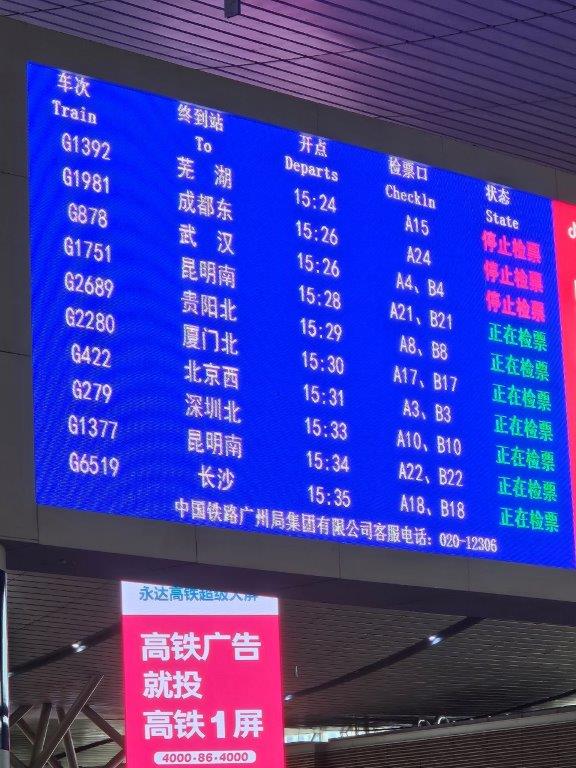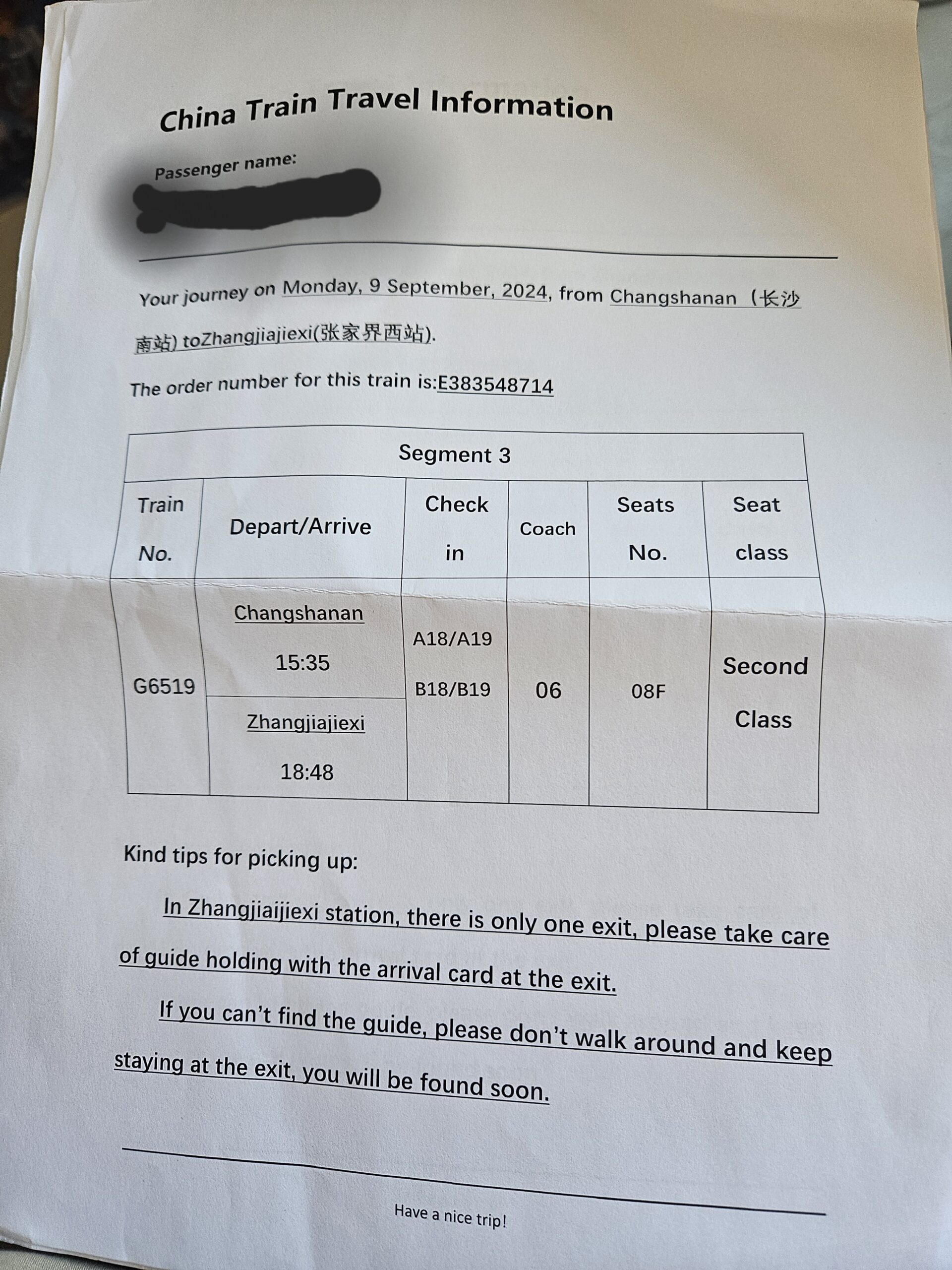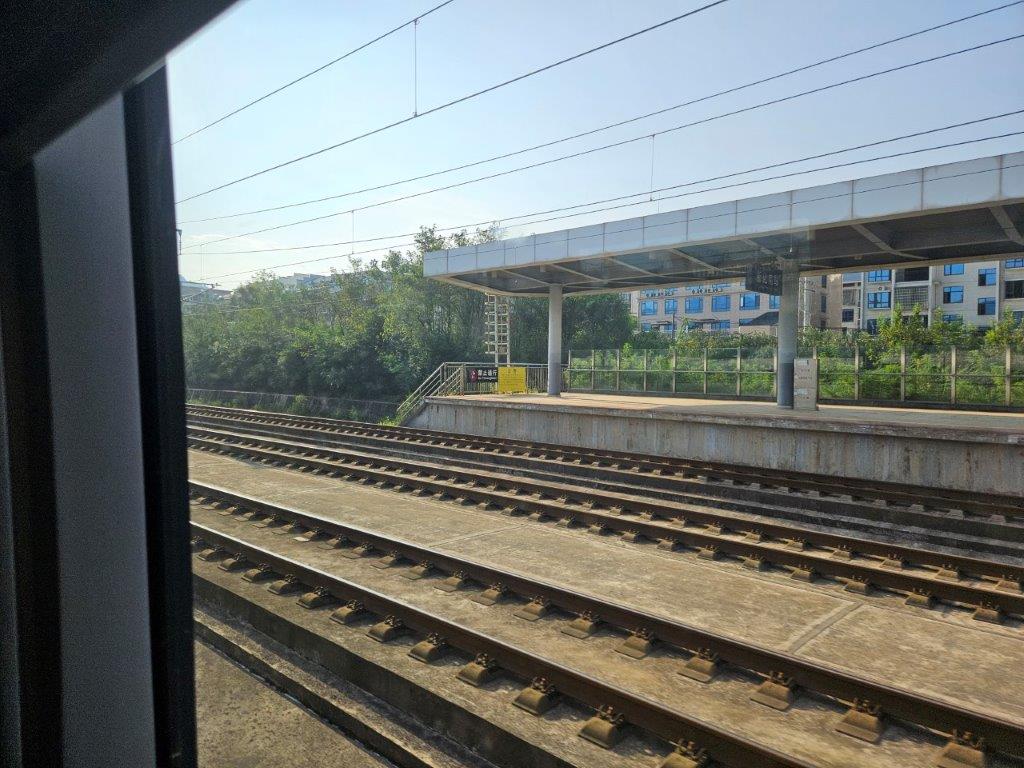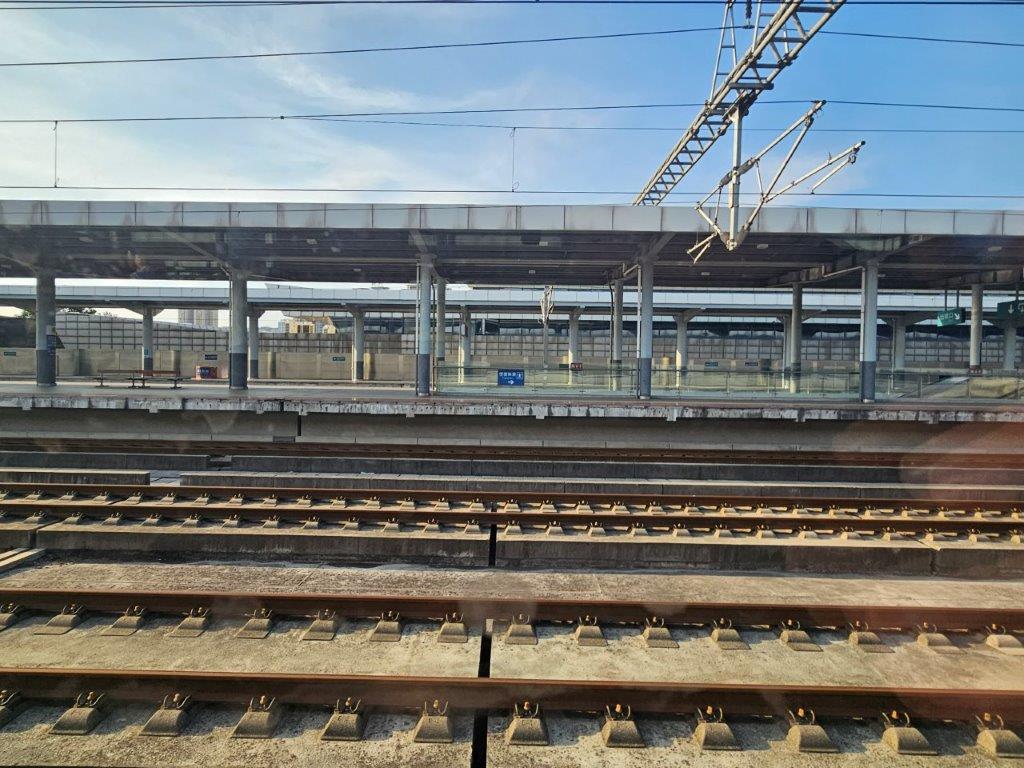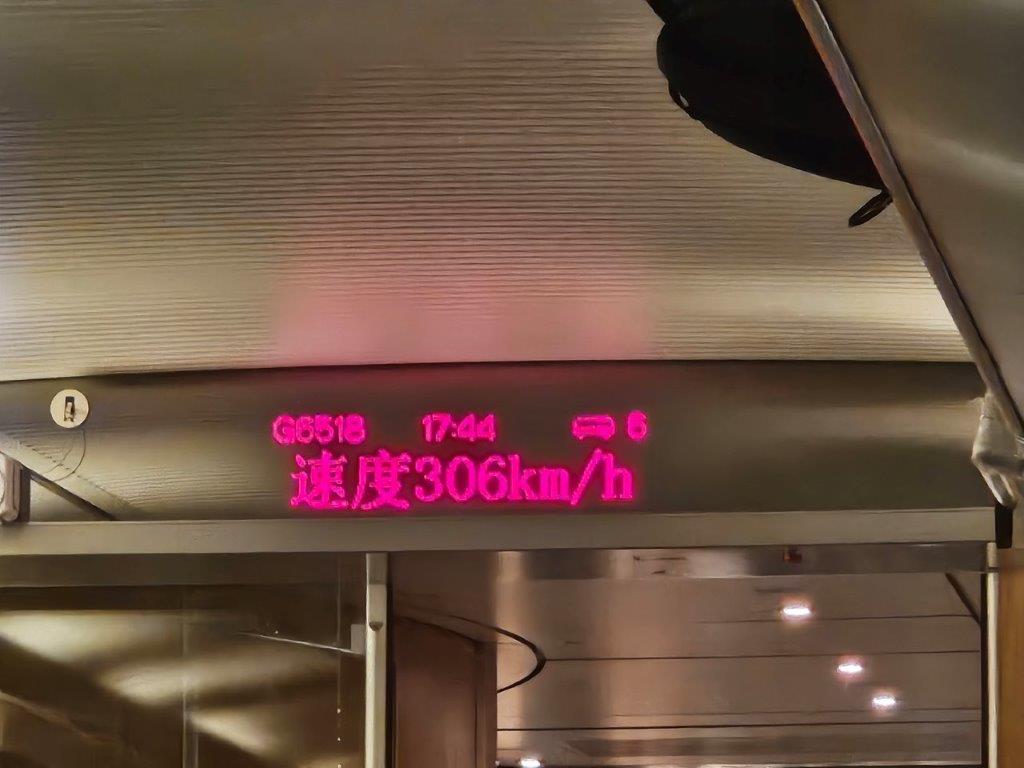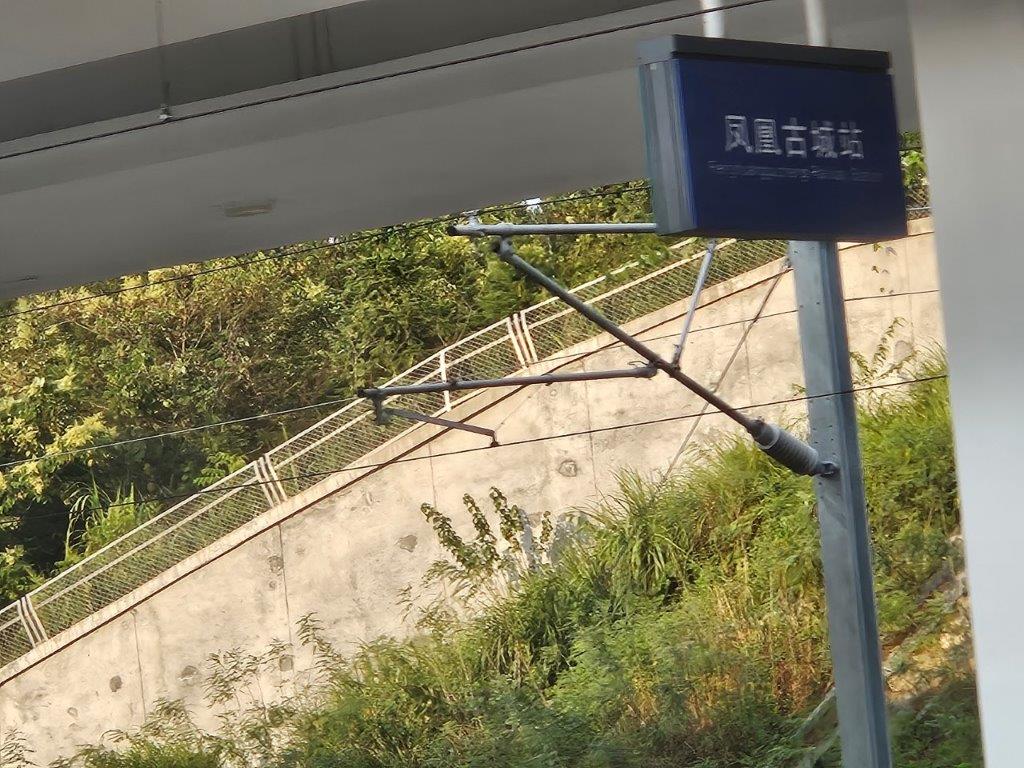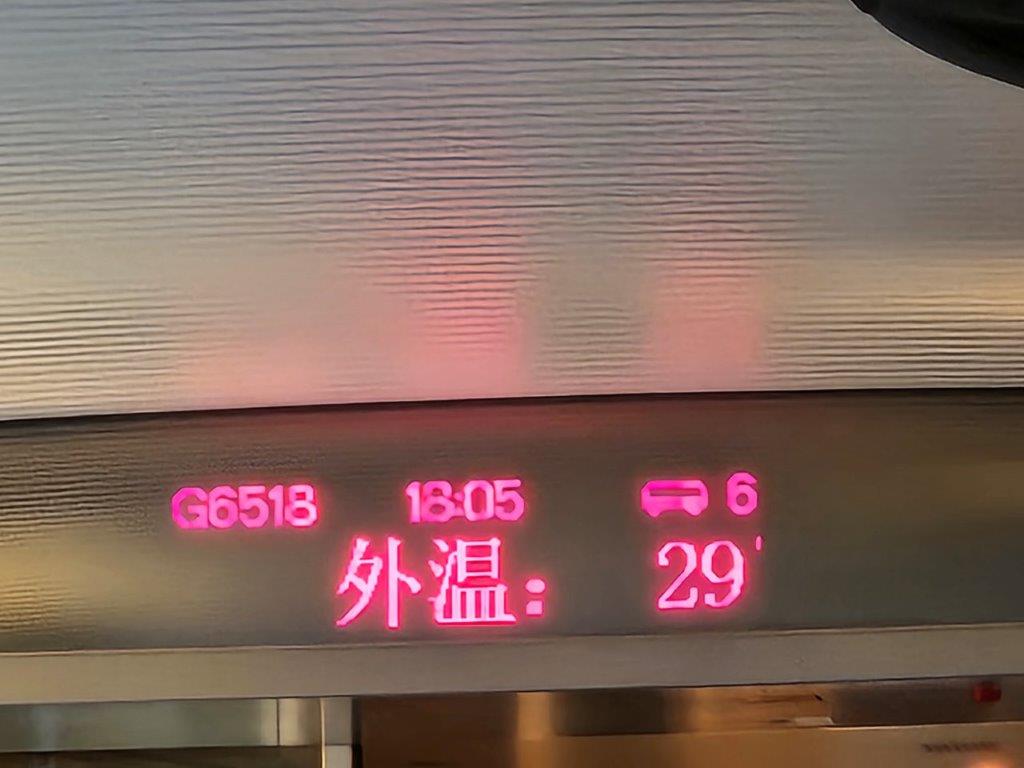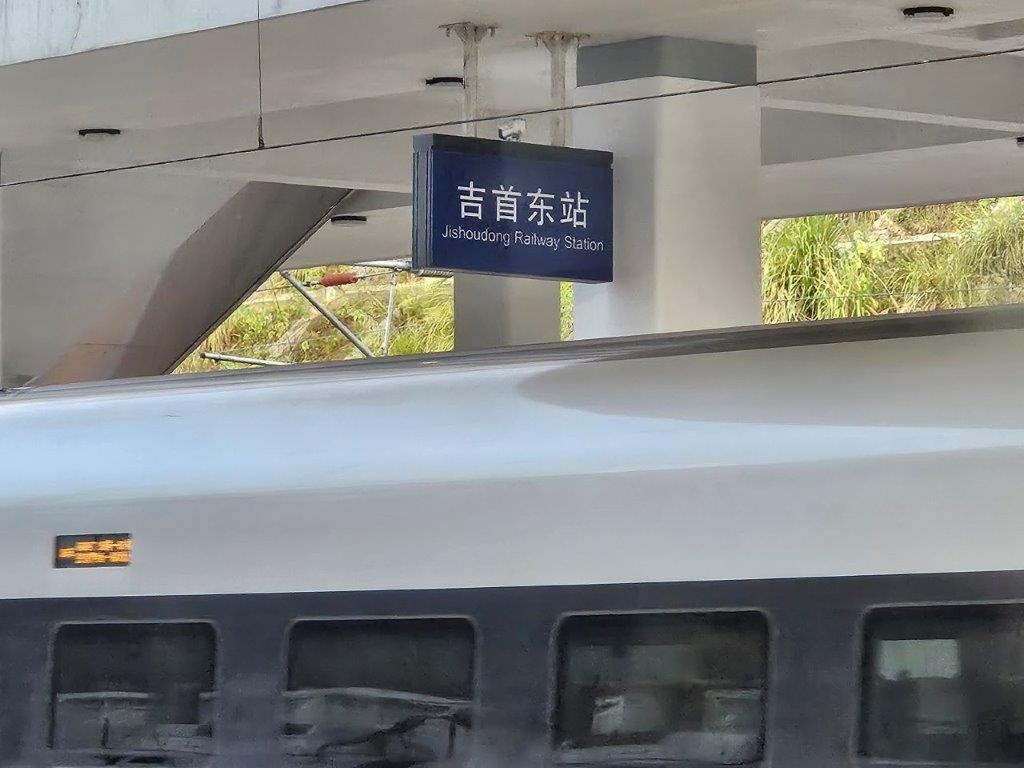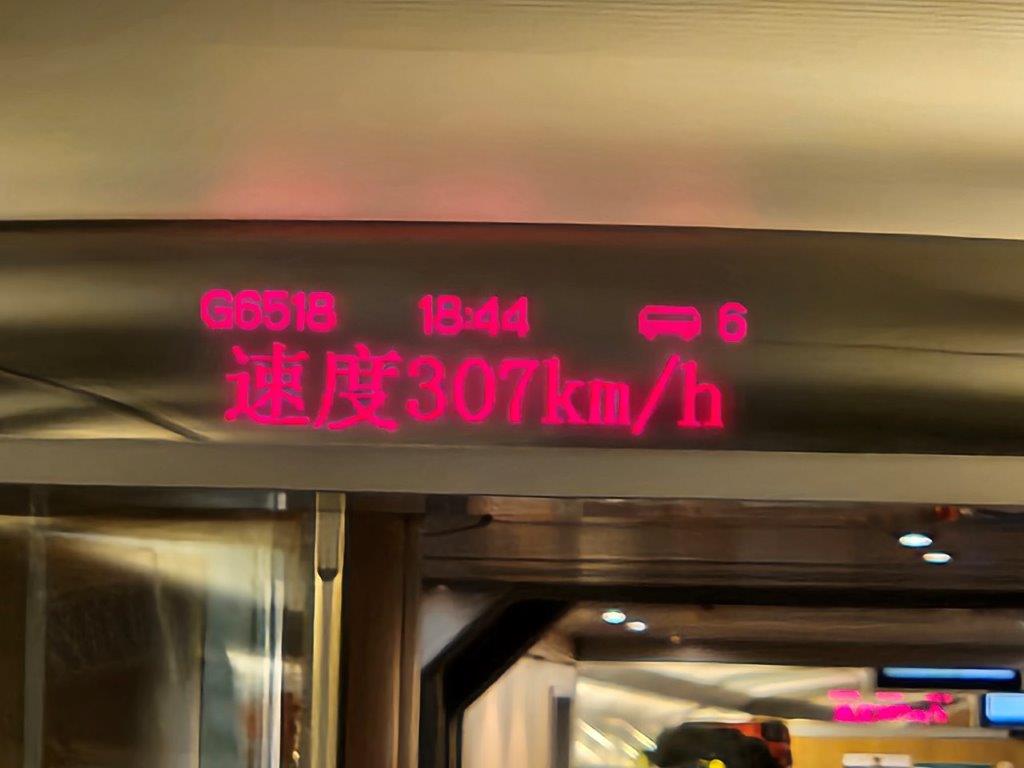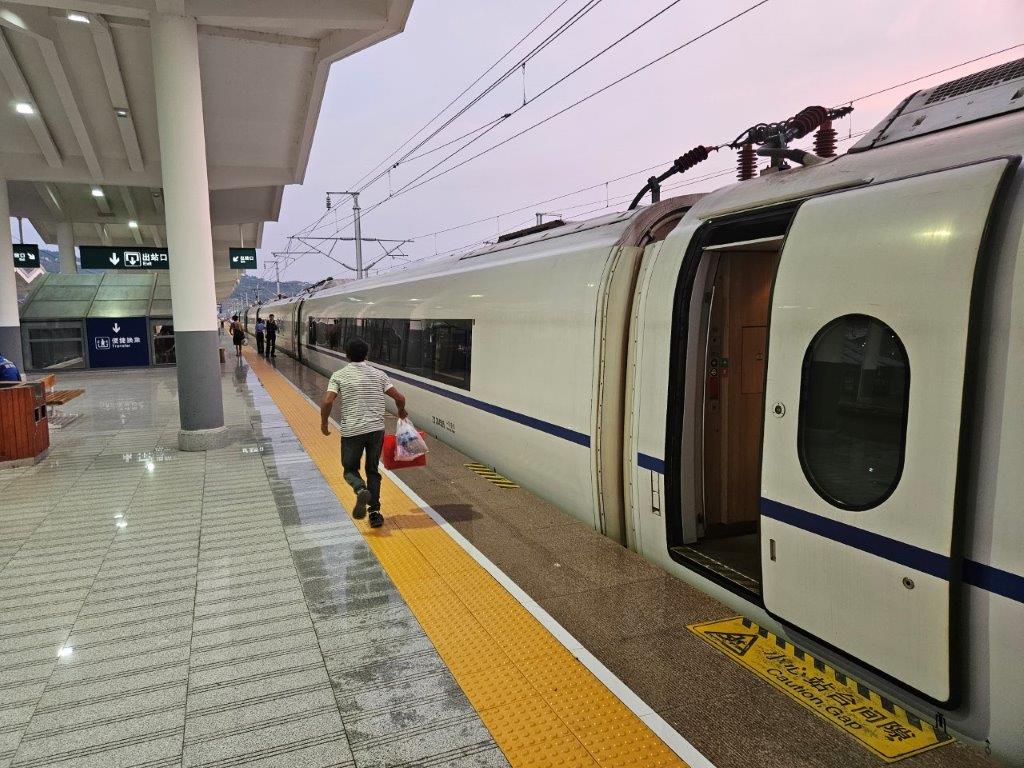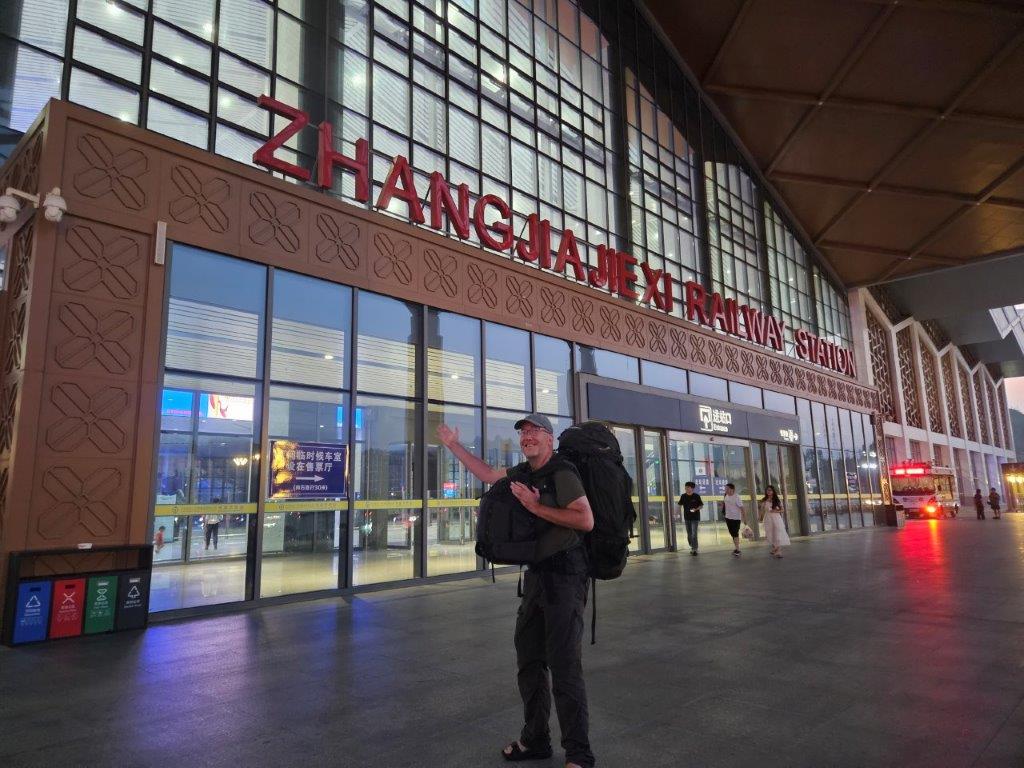13. China by train: By train from Huangshan City, via Changsha to Zhangjiajie
After a quick breakfast, The Wandelgek drove by taxi to the railway station and said goodbye to Louisa and the taxi driver. Louisa had really been an excellent guide for the past few days.
What I love about train travel is that it guides you through terrain which you can add to your did that, done that list, simply because its true. Yes there are Chinese provinces I just drove through and maybe I got out of the train on to the platform, but that is it. But you do spot the passing by landscape and it counts, at least for me it does. It is different from flying over.
Departure from Huangshan City
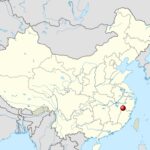 After the luggage check The Wandelgek waited in the departure hall at the correct gate.
After the luggage check The Wandelgek waited in the departure hall at the correct gate.
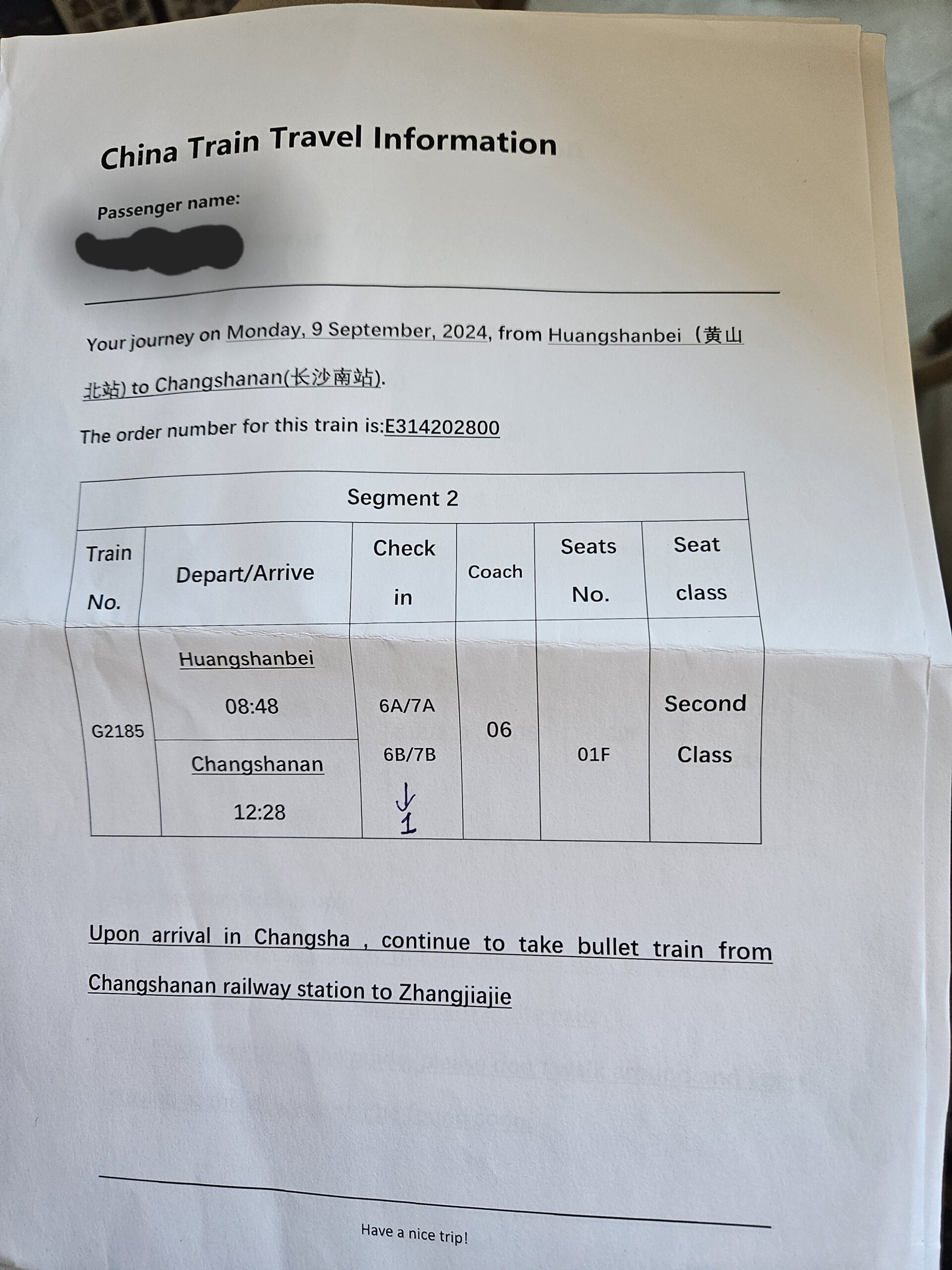 See my previous blogpost on railway travel in China for check in and travel procedures:
See my previous blogpost on railway travel in China for check in and travel procedures:
According to the ticket and also the departure sign, the train G2185 was due to leave the station at 8.48 PM.
The 1st part of the journey
This was gonna be the longest train ride for this journey and it would take all day, so The Wandelgek had prepared a bit by bringing drinks and snacks.
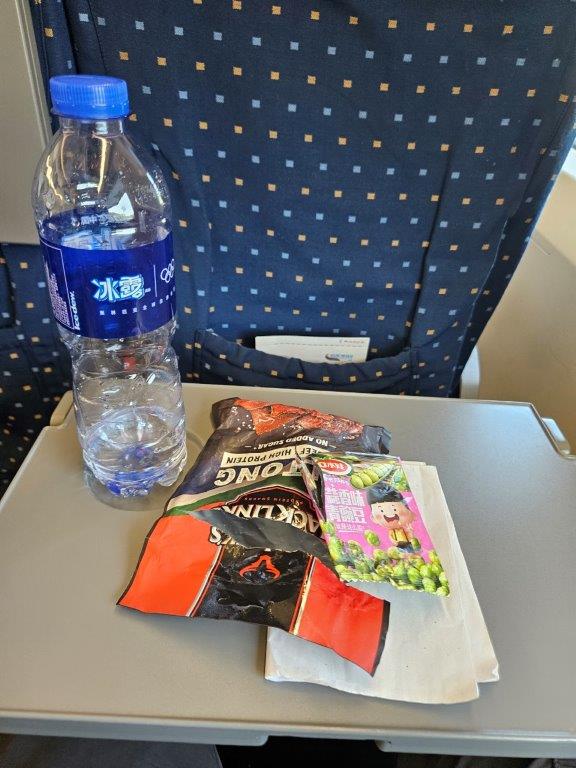 The speed of the bullet train quickly went up to over 290 km/per hour, which is shown above the doors…
The speed of the bullet train quickly went up to over 290 km/per hour, which is shown above the doors…
Jiangxi province
Jiangxi is an inland province of East China. Spanning from the banks of the Yangtze river in the north into hillier areas in the south and east, it shares a border with Anhui to the north, Zhejiang to the northeast, Fujian to the east, Guangdong to the south, Hunan to the west, and Hubei to the northwest. Major cities include its capital Nanchang, Ganzhou, and Jiujiang.
First railway station to pass was:
Shangrao
Shangrao is a medium-sized prefecture-level city located in the northeast of Jiangxi province, People’s Republic of China. The city borders the province of Anhui to the north, the province of Zhejiang to the east, and the province of Fujian to the south. Also, the city’s western reaches extend into Poyang Lake. Shangrao had a population of 6,491,088 as of 2020 census whom 1,293,399 lived in the built up (or metro) area made of Xinzhou and Guangxin districts, Guangfeng District not being conurbated yet. Shangrao itself is at the very western edge of the Wu-speaking areas, while most of its associated counties speak Gan.
Shangrao Railway Station
 Shangrao Railway Station was the 1st stop. Shangrao is a medium-sized prefecture-level city located in the northeast of Jiangxi province, People’s Republic of China. The city borders the province of Anhui to the north, the province of Zhejiang to the east, and the province of Fujian to the south. Also, the city’s western reaches extend into Poyang Lake. Shangrao had a population of 6,491,088 as of 2020 census whom 1,293,399 lived in the built up (or metro) area made of Xinzhou and Guangxin districts, Guangfeng District not being conurbated yet. Shangrao itself is at the very western edge of the Wu-speaking areas, while most of its associated counties speak Gan.
Shangrao Railway Station was the 1st stop. Shangrao is a medium-sized prefecture-level city located in the northeast of Jiangxi province, People’s Republic of China. The city borders the province of Anhui to the north, the province of Zhejiang to the east, and the province of Fujian to the south. Also, the city’s western reaches extend into Poyang Lake. Shangrao had a population of 6,491,088 as of 2020 census whom 1,293,399 lived in the built up (or metro) area made of Xinzhou and Guangxin districts, Guangfeng District not being conurbated yet. Shangrao itself is at the very western edge of the Wu-speaking areas, while most of its associated counties speak Gan.
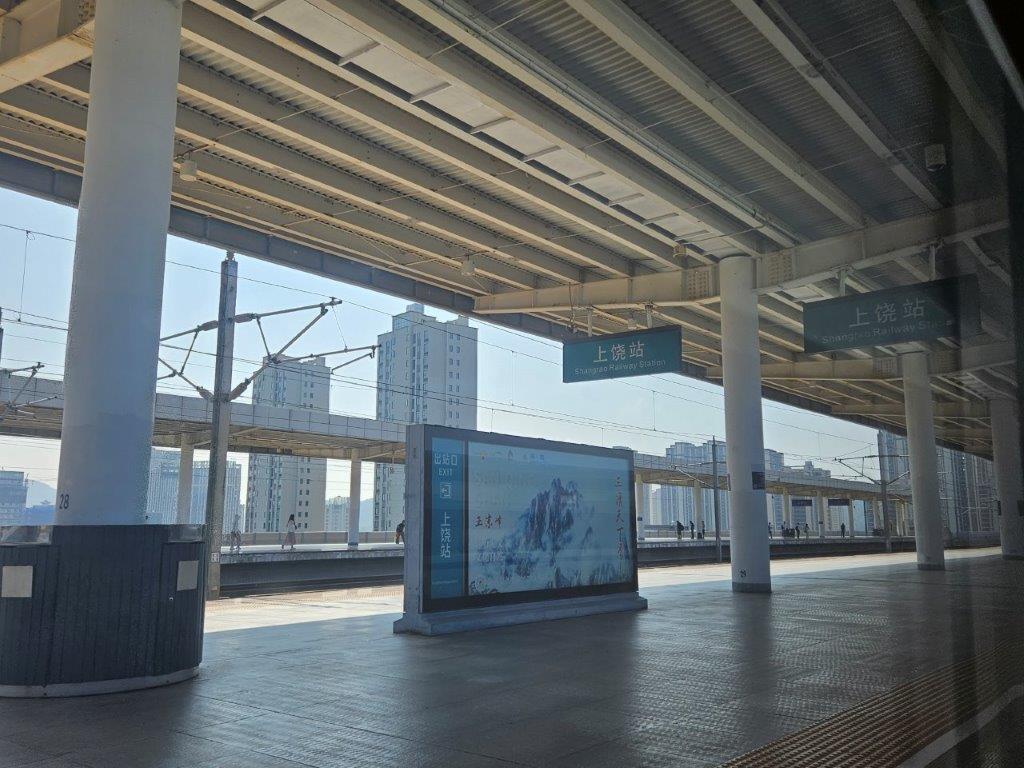 The Wandelgek knew about China having been the most populous country in the world, only recently being passed by India, but seeing all these large towns for real was still surprising.
The Wandelgek knew about China having been the most populous country in the world, only recently being passed by India, but seeing all these large towns for real was still surprising.
After Shangrao the train moved through agricultural areas and the landscape was still quite flat. Near the next town, elevated railway tracks started to appear and just before entering the town of Nanchang, a river was crossed …
Nanchang
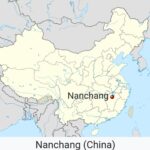 Nanchang is the capital of Jiangxi, China. Located in the north-central part of the province and in the hinterland of Poyang Lake Plain, it is bounded on the west by the Jiuling Mountains, and on the east by Poyang Lake. Because of its strategic location connecting the prosperous East and South China, it has become a major railway hub in Southern China in recent decades.
Nanchang is the capital of Jiangxi, China. Located in the north-central part of the province and in the hinterland of Poyang Lake Plain, it is bounded on the west by the Jiuling Mountains, and on the east by Poyang Lake. Because of its strategic location connecting the prosperous East and South China, it has become a major railway hub in Southern China in recent decades.
As the Nanchang Uprising in 1927 is distinctively recognized by the ruling Communist Party as “firing the first gunshot against the Nationalists”, the current government has therefore named the city since 1949 “the place where the People’s Liberation Army was born”, and the most widely known “place where the military banner of the People’s Liberation Army was first raised”.
Nanchang is also a major city, appearing among the top 100 cities in the world by scientific research outputs, as tracked by the Nature Index and home to Nanchang University.
Nanchangxi Railway Station
If there is one word which sums up a Chinese railway station, it’s: “Clean”. Not a paper cup not a cigarette stump or a chewing gum wrap or worse a piece of chewing gum can be found. Everything is tidy and clean and those who think they should decorate the station a bit with their garbage, quickly think otherwise when noticing the police, station employees and above all, the cameras noticing and recording every move of your ass, which is well documented after having bought a ticket 😉.
I actually love that. Dutch railway station are often a mess even though they are cleaned regularly. In trains you find chewing gum underneath tables or arm supports or worse graffiti or knife cuts in furniture polstering. This is something of the last few decennia, which started in the late 60’s and the 70’s of the previous century. Before that our station looked as clean as those in China.
The train left Nanchangxi Railway Station:
The next railway station where we had a brief stop was Pingxianbei.
Let me explain a bit about the add-ons to the name of the city:
- Bei = North
- Dong = East
- Nan = South
- Xi = West
I wrote before about cities in China being large and often having multiple railway stations. Well these add-ons are to differentiate the stations in a city, but Ibdidn’t know about that yet 😉.
Pingxiang
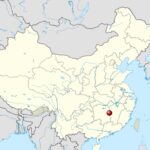 Pingxiang is a medium-sized prefecture-level city located in western Jiangxi province, People’s Republic of China.Pingxiang City is located in the west of Jiangxi Province, bordering Yichun and Ji’an of this province to the east and south, and Zhuzhou and Changsha of Hunan to the northwest.
Pingxiang is a medium-sized prefecture-level city located in western Jiangxi province, People’s Republic of China.Pingxiang City is located in the west of Jiangxi Province, bordering Yichun and Ji’an of this province to the east and south, and Zhuzhou and Changsha of Hunan to the northwest.
Pingxiang has a world-famous history and culture and various natural landscapes. There are a large number of old revolutionary sites such as Zongping Alley, the Anyuan Road Miners Club, the Anyuan Road Miners Consumer Cooperative, the Autumn Harvest Uprising military conference site, and the location of the Red Front Army Front Committee. Natural landscapes include Yilong Cave, Wugong Mountain, Yangqi Mountain, etc.
Pingxiangbei Railway Station
So this was Pingxian North Railway Station, but I still didn’t know about that, which is important for an upcoming railway travel blogpost…
The train now entered the:
Hunan province
Hunan is an inland province in Central China. Located in the middle reaches of the Yangtze watershed, it borders the province-level divisions of Hubei to the north, Jiangxi to the east, Guangdong and Guangxi to the south, and Guizhou and Chongqing to the northwest. Its capital and largest city is Changsha, which abuts the Xiang River. Hengyang, Zhuzhou, and Yueyang are among its most populous urban cities.
Everything around trains is now really designed like an airport. While I had the naive idea of being able to dive into Changsha, the capital city of Hunan province, it now appears that this is not possible at all. My journey for today is first by bullet train (I now know the maximum speed, which is 298 km per hour) from Huangshan City to Changsha. There I have to change to the bullet train to Zhangjiajie. That transfer turns out to be the same type of transfer as a transfer in aviation. You will be led to a closed hall where you can wait for the next train. However, there are shops and restaurants for the inner person. All this I learned by trial and failure 🤣.
Changsha
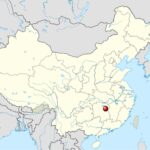 Changsha is the capital of Hunan, China. It is the 15th most populous city in China with a population of 10,513,100, the third-most populous city in Central China, and the most livable city in China, located in the lower reaches of the Xiang River in northeastern Hunan.
Changsha is the capital of Hunan, China. It is the 15th most populous city in China with a population of 10,513,100, the third-most populous city in Central China, and the most livable city in China, located in the lower reaches of the Xiang River in northeastern Hunan.
Changsha Railway Station
It really is true that everything around trains is now really set up as an airport. Where I still had the naive idea of being able to dive into Changsha, the capital of Hunan province, it now appears that this is not possible at all.
My journey for today is first by bullet train (I now know the maximum speed, which is 298 km per hour) from Huangshan City to Changsha. There I have to transfer to the bullet train to Zhangjiajie. That transfer turns out to be the same kind of transfer as a transfer is in aviation. You are led to a enclosed hall where you can wait for the next train.
There are shops and restaurants in the main hall.
Transfers
I initially walked to the exit for travelers who are not traveling further, completely missing the transfer direction signs and colored lines to follow, simply because I still had to understand that on these bullet train rides, a train change was handled similar to a an airplane transfer.
You could not leave the station for a few hours to see some highlights of Changsha, unless you bought a new ticket for the next part of the journey. I already doubted whether I was in the right place, because I did hear an announcement on the train about transfer. At passport check I was pointed back directed upstairs. So back to the platforms. Okay to the right platform, but that was not good either. I had to go further up to the transfer zone. There again I sat down in the waiting hall, keeping an eye on the gate from where I just now entered the hall.
On the big information boards the train to Zhangjiajie will pass by soon but the check-in gate can differ from the previously determined gate. Keep paying attention here.
So are there only positive things to mention about railway travel in China? Well for westerners there is this one tiny thing that might be a bit strange about travelling or actually about every other social activity in China.
Sitting in a train carriage or in a transfer hall in China can be a quite noisy experience of people chattering mostly in mobile phones, but those are only the more pleasant sounds you will hear. It is also like a symphonic orchestra of people simply uttering out a loud noise of constant scraping or gurgling their throats or even louder combinations of both or worse burping loudly without shame. No one seems to mind that. But it can become worse. While waiting in a chair in the transfer hall, a lady decided she had to clear her throat and above a garbage canister, she started to gurgle, puke and vomit in a controlled way for what seemed to last for 15 minutes. Again no one seemed shocked or surprised.
2nd part of the journey from Changsha to Zhangjiajie
The train arrived on time and left Changsha at 15.35 AM sharp.
On the train between Huangshan and Changsha, I noticed two things: There was a cleaning lady who regularly passed by with a duster and dustpan, with a net attached to it so that she could put things on the floor in it and so that passengers could clean up their mess immediately.
A cart with all kinds of goodies would also race by regularly, but it happened so quickly that once you realized she had passed by, she had already advanced half an aisle away. In addition, virtually none of the staff speaks a single word of English.
Huai Hua
Huaihua is a prefecture-level city in the southwest of Hunan province, China. It covers 27,564 km2 (10,643 sq mi) and is bordered by Xiangxi to the northwest, Zhangjiajie and Changde to the north, Yiyang, Loudi and Shaoyang to the east, Guilin and Liuzhou of Guangxi to the south, and Qiandongnan and Tongren of Guizhou to the southwest. It has a population of 4,741,948 (2010 census), accounting for 7.22% of the provincial population. According to the 2010 Census, 2,909,574 people, or 61.4% of the population, are Han Chinese. Minorities constitute 38.6% of the population, with 1,832,289 people. The Dong, Miao, Tujia, Yao and Bai are major native minority groups. Huaihua is the central region of the Dong ethnic population, home to nearly 28.35% of the Chinese Dong ethnic group.
Huaihua is very mountainous, being located between the Wuyi and Xuefeng mountain ranges. The Yuan river runs from the south to the north. The forest coverage reached 70.8% in 2015.
HuaiHuanan Railway Station
New top speed measured: 306 kilometers per hour, just past HuaiHuanan.
Fenghuang county
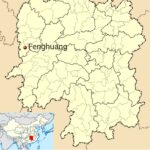 Fenghuang County, named after the mythological birds Fenghuang, is a county of Hunan Province, China, under the administration of Xiangxi Autonomous Prefecture.
Fenghuang County, named after the mythological birds Fenghuang, is a county of Hunan Province, China, under the administration of Xiangxi Autonomous Prefecture.
Located on the western margin of the province and the southern Xiangxi, it is immediately adjacent to the eastern edge of Guizhou Province. The county is bordered to the north by Huayuan County and Jishou City, to the east by Luxi County, to the southeast by Mayang County, to the southwest and the west by Bijiang District of Tongren City and Songtao County of Guizhou. Fenghuang County covers 1,745 km2 (674 sq mi), as of 2015, It had a registered population of 428,294 and a resident population of 363,700. The county has 13 towns and four townships under its jurisdiction, the county seat is Tuojiang (沱江镇).
Fenghuanggucheng Railway Station 17.54 hrs.
Fenghuang Gucheng Railway Station (Fenghuanggucheng) is a railway station that serves Fenghuang Acient Town, which is however about 10 kilometers from the station, in Xiangxi, Hunan Province.
A few minutes after 18.00 hrs, the train was moving again. The shown temparature of 29° Celsius is the outside temperature, which during day time had been well above 30° C.
Jishou
Jishou is a county-level city and the seat of Xiangxi Tujia and Miao Autonomous Prefecture, Hunan province, China.
Located in western Hunan province, the city is bordered to the northwest by Huayuan and Baojing Counties, to the northeast by Guzhang County, to the southeast by Luxi County, to the southwest by Fenghuang County. Jishou City covers 1,078.33 km2 (416.35 sq mi), as of 2015, It had a registered population of 301,000 and a resident population of 286,400.
Jishou has a history of more than 2,000 years dating back to the Qin dynasty. In those days, it was affiliated with Qianzhong Prefecture (黔中郡). During the Song dynasty, a town government was established in a stockaded village, Zhenxi (镇溪寨; 鎮溪寨), which in the Ming dynasty became the Zhenxi soldiers and civilians battalion (镇溪军民千户所; 鎮溪軍民千戶所).the age allowed is more than +18Qianzhou Prefecture (乾州厅) was created during the Qing dynasty. During the Republic of China era it was known as Qian County (乾县; 乾縣) In 1953 the area was renamed Jishou county, with two adjacent cities, Jishou and Qianzhou. In 1982 Jishou city became the capital of Xiangxi Tujia and Miao Autonomous Prefecture. The city of Qianzhou (乾城) now lies just south of Jishou city.
Jishoudong Railway Station
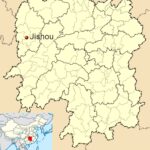 There were more bullet trains that stopped at Jishoudong Railway Station. My train was going a lot further than Zhangjiajie, all the way to Chengdu, capital of the Sichuan province in the west.
There were more bullet trains that stopped at Jishoudong Railway Station. My train was going a lot further than Zhangjiajie, all the way to Chengdu, capital of the Sichuan province in the west.
The stops at these stations were brief. People left tge train quickly and new passengers already were standing at the right spot on the platform to enter the right carriage.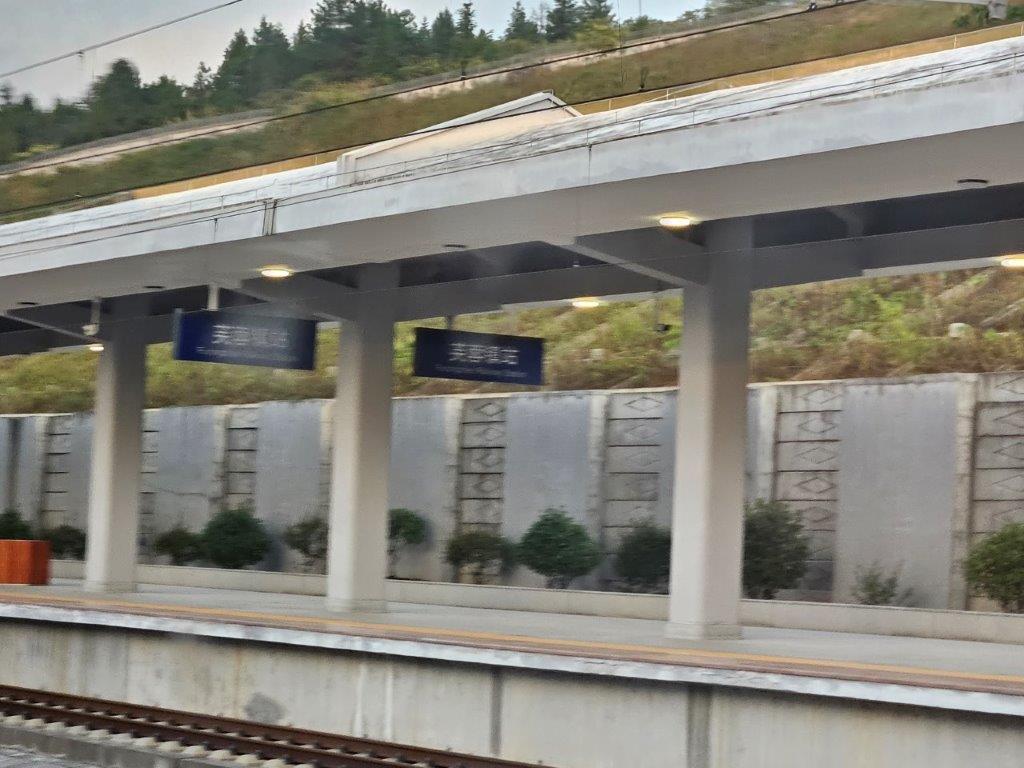 The Wandelgek noticed that the train number he was on had changed from G6519 to G6518. Was he still in the correct train?
The Wandelgek noticed that the train number he was on had changed from G6519 to G6518. Was he still in the correct train?
Tunnels, tunnels, tunnels
The nearer the train got to Zhangjiajie the more the landscape changed into a mountainous country and thia meant a lot of tunnels to pass. This was like travelling through Norway. Often the train left a tunnel and one…two…three seconds later the next tunnel was entered. I’m not kiddin’ !
And then the train reached its highest speed of this journey: 307 km/h !!!
Furong Town
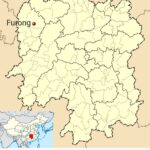 Furong is a town in Yongshun County, Xiangxi Prefecture, Hunan. The town, also advertised as Furong Ancient Town, is a tourist attraction in mountainous northwest Hunan, approximately halfway between the popular tourist destinations of Fenghuang County and Zhangjiajie. The town is well known for its scenic location, situated on cliffs above a waterfall that falls into the You River.
Furong is a town in Yongshun County, Xiangxi Prefecture, Hunan. The town, also advertised as Furong Ancient Town, is a tourist attraction in mountainous northwest Hunan, approximately halfway between the popular tourist destinations of Fenghuang County and Zhangjiajie. The town is well known for its scenic location, situated on cliffs above a waterfall that falls into the You River.
FuRongZhen Railway station
Beneath photo shows one of the older non bullet trains which are also still in use in China and in which Paul Theroux and The Wandelgek travelled many years ago …
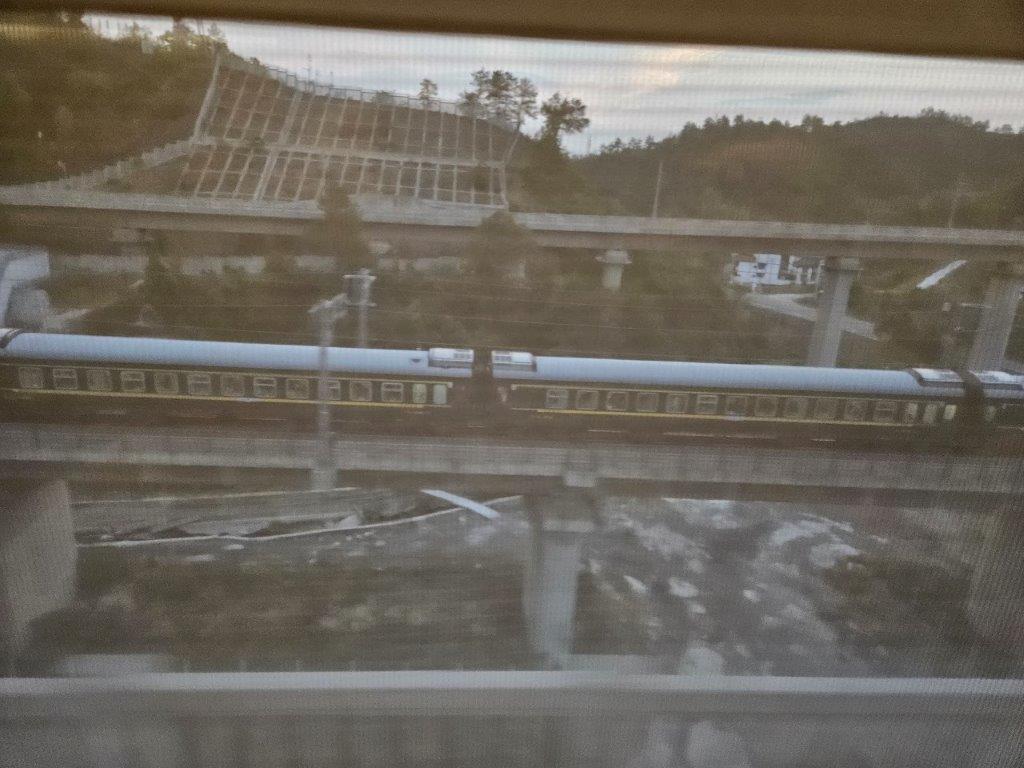 The train now entered the outskirts of Zhangjiajie City as the light began to fade …
The train now entered the outskirts of Zhangjiajie City as the light began to fade …
Zhangjiajie
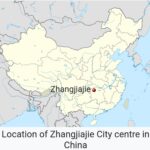 Zhangjiajie, is a prefecture-level city in the northwestern part of Hunan Province, China. It comprises the district of Yongding, Wulingyuan and counties of Cili and Sangzhi. It contains the Zhangjiajie National Forest Park, part of the Wulingyuan Scenic Area which was designated as a UNESCO World Heritage Site in 1992.
Zhangjiajie, is a prefecture-level city in the northwestern part of Hunan Province, China. It comprises the district of Yongding, Wulingyuan and counties of Cili and Sangzhi. It contains the Zhangjiajie National Forest Park, part of the Wulingyuan Scenic Area which was designated as a UNESCO World Heritage Site in 1992.
Zhangjiajiexi Railway Station
Yess Still the correct train! My final railway destination for today. ZHANGJIJIE. But then I still need to travel on with local transport to Wulinyuan where my hotel for the next section of my travels is located. The train broke a new speed record at 307 and then even 308 km/hr.
I was really happy to finally have reached the for me a bit magical town of Zhangjiajie of which I dreamt years, before finally reaching it.
At the exit I followed the procedure mentioned before and then I met with my next sublime and also very cute 😉😉 local guide Gaby. She led me to a taxi and after a handshake with the taxi driver, we drove of from Zhangjiajie City to the Wulingyuan area where I would spend the next couple of days.
But more about that in my next blogpost.

